People in Organisations: Analysis of Google UK Limited Behaviour
VerifiedAdded on 2023/06/17
|13
|3513
|100
Report
AI Summary
This report examines organizational behaviour and people management within organizations, focusing on Google UK Ltd. It explores organizational culture, power dynamics, and motivational theories, including Handy's culture types and French and Raven's forms of power. The report also discusses motivational techniques like Adam's Equity Theory and Hertzberg's Two-Factor Theory, emphasizing the importance of both hygiene and motivating factors. Furthermore, it differentiates between effective and ineffective teams and applies Belbin's Team Role theory. The reflection highlights the significance of organizational culture, politics, power allocation, and motivation in achieving business objectives, recommending employee involvement in decision-making, focusing on content theory for motivation, and managing internal politics to improve organizational culture. Desklib offers this assignment and many other resources for students.
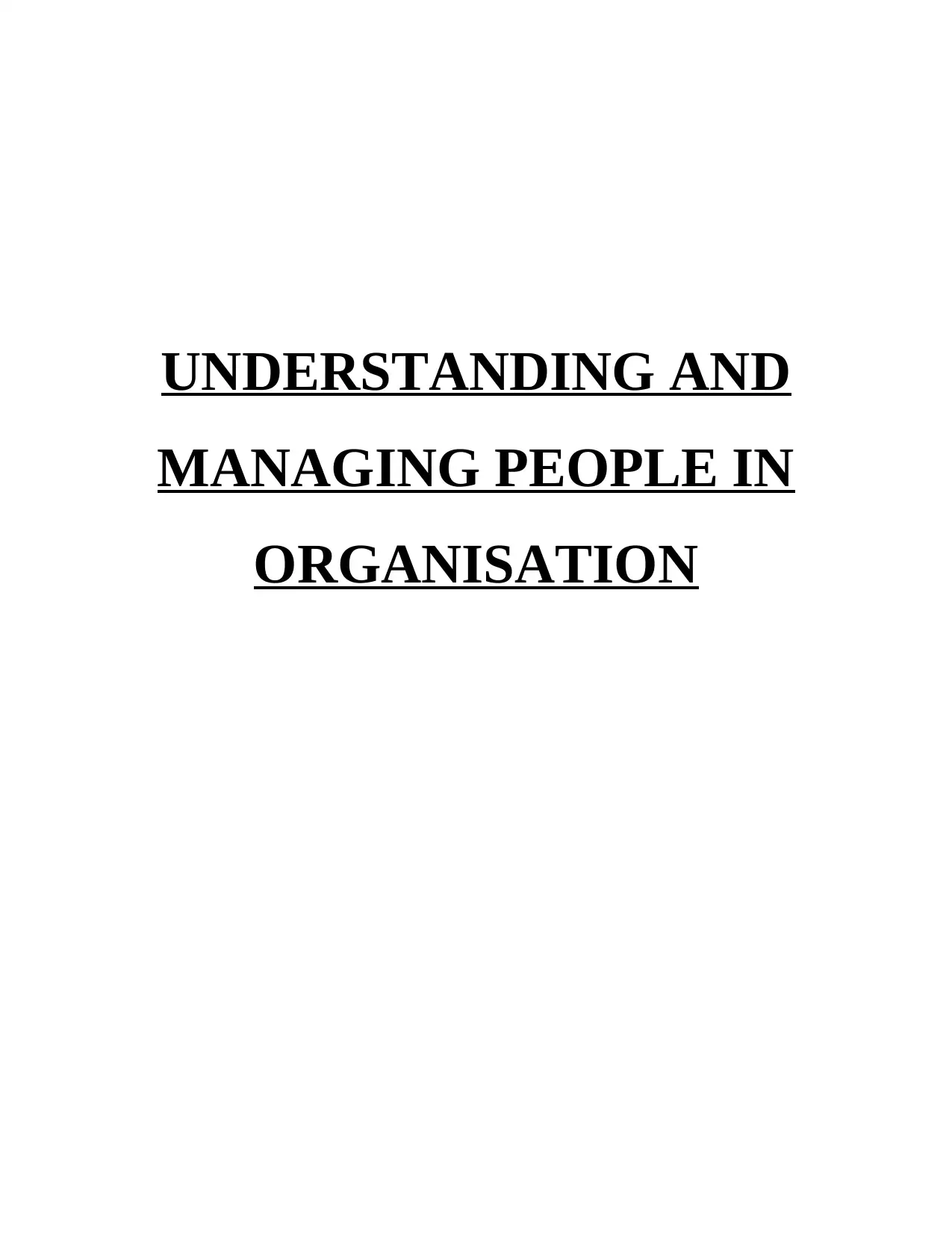
UNDERSTANDING AND
MANAGING PEOPLE IN
ORGANISATION
MANAGING PEOPLE IN
ORGANISATION
Paraphrase This Document
Need a fresh take? Get an instant paraphrase of this document with our AI Paraphraser
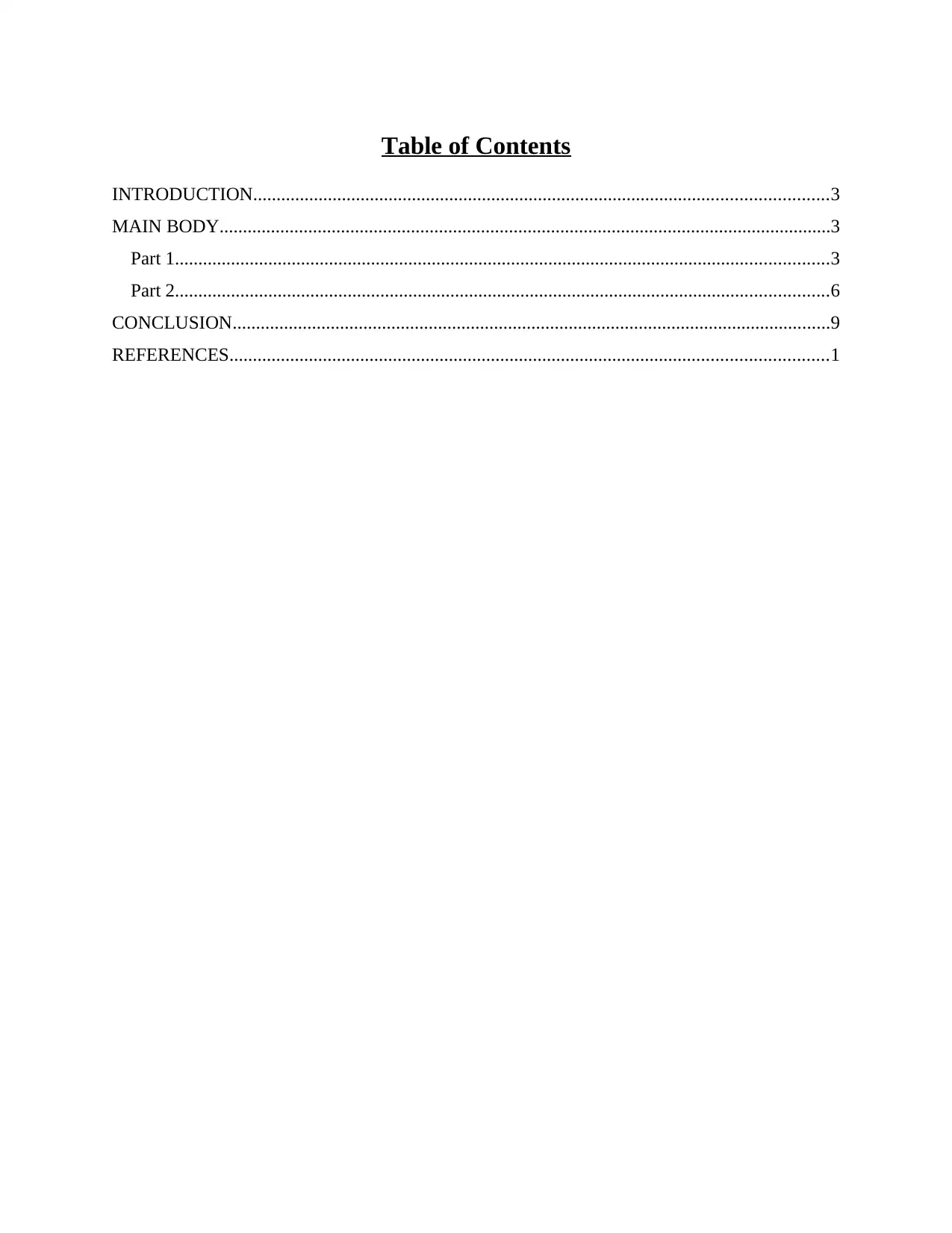
Table of Contents
INTRODUCTION...........................................................................................................................3
MAIN BODY...................................................................................................................................3
Part 1............................................................................................................................................3
Part 2............................................................................................................................................6
CONCLUSION................................................................................................................................9
REFERENCES................................................................................................................................1
INTRODUCTION...........................................................................................................................3
MAIN BODY...................................................................................................................................3
Part 1............................................................................................................................................3
Part 2............................................................................................................................................6
CONCLUSION................................................................................................................................9
REFERENCES................................................................................................................................1
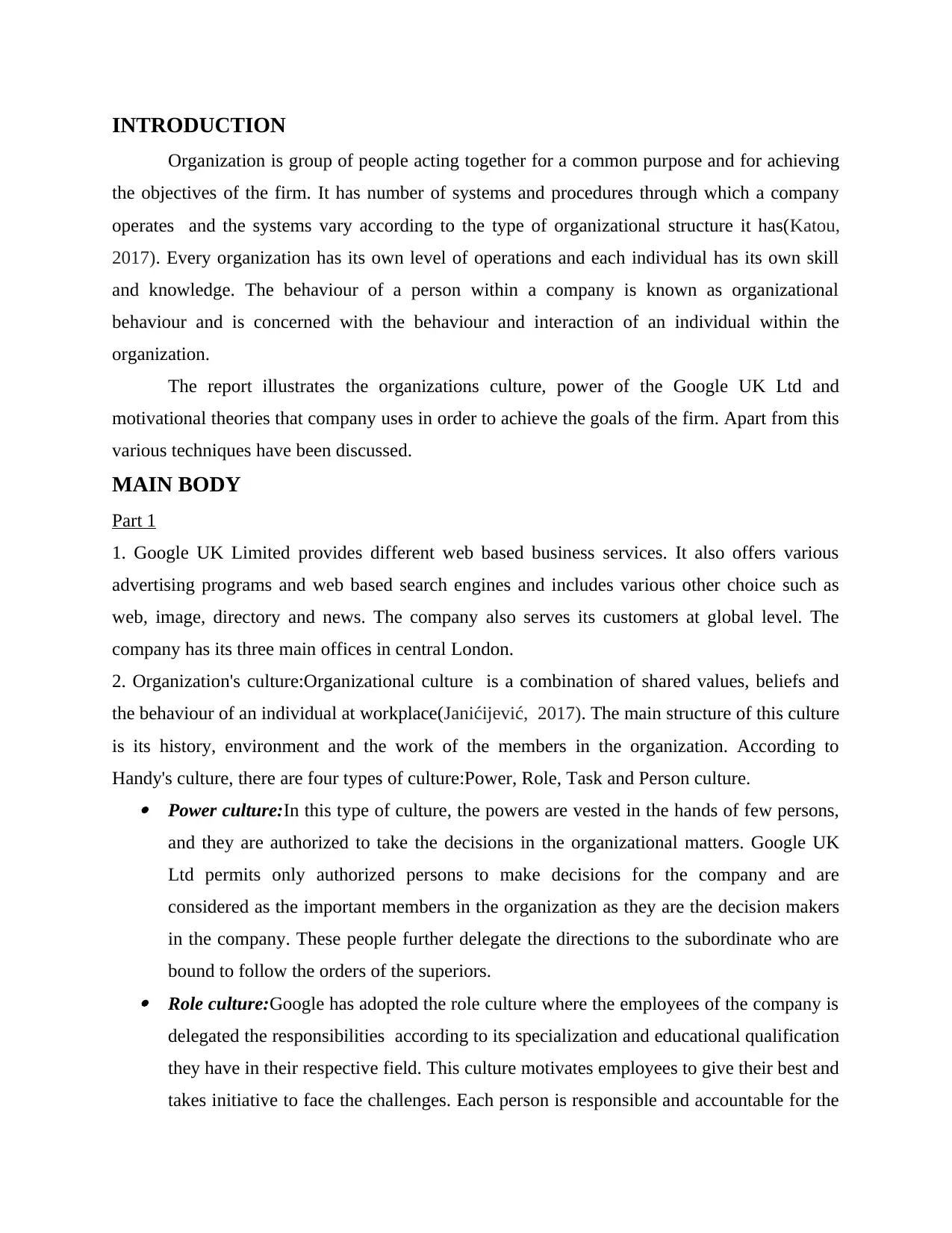
INTRODUCTION
Organization is group of people acting together for a common purpose and for achieving
the objectives of the firm. It has number of systems and procedures through which a company
operates and the systems vary according to the type of organizational structure it has(Katou,
2017). Every organization has its own level of operations and each individual has its own skill
and knowledge. The behaviour of a person within a company is known as organizational
behaviour and is concerned with the behaviour and interaction of an individual within the
organization.
The report illustrates the organizations culture, power of the Google UK Ltd and
motivational theories that company uses in order to achieve the goals of the firm. Apart from this
various techniques have been discussed.
MAIN BODY
Part 1
1. Google UK Limited provides different web based business services. It also offers various
advertising programs and web based search engines and includes various other choice such as
web, image, directory and news. The company also serves its customers at global level. The
company has its three main offices in central London.
2. Organization's culture:Organizational culture is a combination of shared values, beliefs and
the behaviour of an individual at workplace(Janićijević, 2017). The main structure of this culture
is its history, environment and the work of the members in the organization. According to
Handy's culture, there are four types of culture:Power, Role, Task and Person culture. Power culture:In this type of culture, the powers are vested in the hands of few persons,
and they are authorized to take the decisions in the organizational matters. Google UK
Ltd permits only authorized persons to make decisions for the company and are
considered as the important members in the organization as they are the decision makers
in the company. These people further delegate the directions to the subordinate who are
bound to follow the orders of the superiors. Role culture:Google has adopted the role culture where the employees of the company is
delegated the responsibilities according to its specialization and educational qualification
they have in their respective field. This culture motivates employees to give their best and
takes initiative to face the challenges. Each person is responsible and accountable for the
Organization is group of people acting together for a common purpose and for achieving
the objectives of the firm. It has number of systems and procedures through which a company
operates and the systems vary according to the type of organizational structure it has(Katou,
2017). Every organization has its own level of operations and each individual has its own skill
and knowledge. The behaviour of a person within a company is known as organizational
behaviour and is concerned with the behaviour and interaction of an individual within the
organization.
The report illustrates the organizations culture, power of the Google UK Ltd and
motivational theories that company uses in order to achieve the goals of the firm. Apart from this
various techniques have been discussed.
MAIN BODY
Part 1
1. Google UK Limited provides different web based business services. It also offers various
advertising programs and web based search engines and includes various other choice such as
web, image, directory and news. The company also serves its customers at global level. The
company has its three main offices in central London.
2. Organization's culture:Organizational culture is a combination of shared values, beliefs and
the behaviour of an individual at workplace(Janićijević, 2017). The main structure of this culture
is its history, environment and the work of the members in the organization. According to
Handy's culture, there are four types of culture:Power, Role, Task and Person culture. Power culture:In this type of culture, the powers are vested in the hands of few persons,
and they are authorized to take the decisions in the organizational matters. Google UK
Ltd permits only authorized persons to make decisions for the company and are
considered as the important members in the organization as they are the decision makers
in the company. These people further delegate the directions to the subordinate who are
bound to follow the orders of the superiors. Role culture:Google has adopted the role culture where the employees of the company is
delegated the responsibilities according to its specialization and educational qualification
they have in their respective field. This culture motivates employees to give their best and
takes initiative to face the challenges. Each person is responsible and accountable for the
⊘ This is a preview!⊘
Do you want full access?
Subscribe today to unlock all pages.

Trusted by 1+ million students worldwide
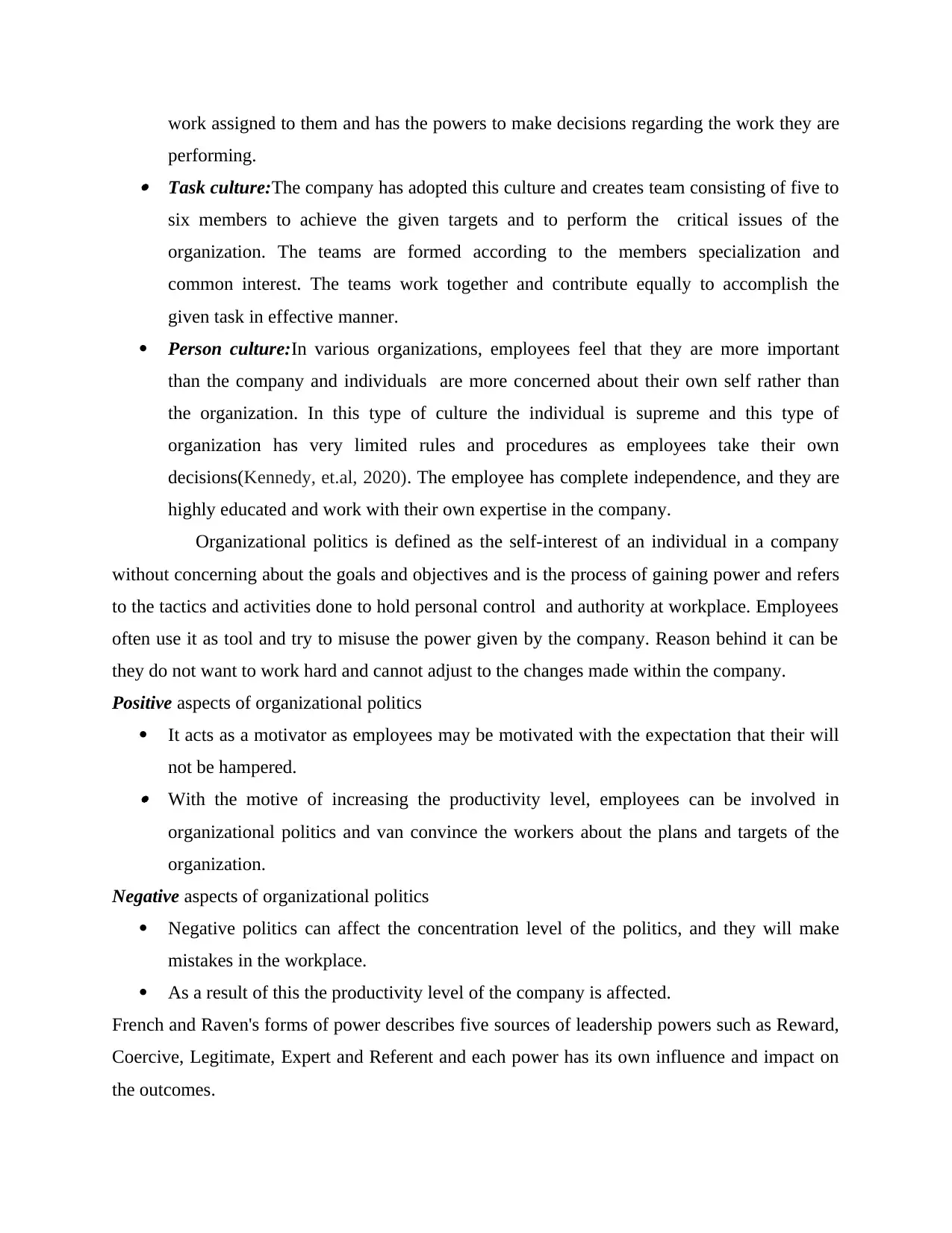
work assigned to them and has the powers to make decisions regarding the work they are
performing. Task culture:The company has adopted this culture and creates team consisting of five to
six members to achieve the given targets and to perform the critical issues of the
organization. The teams are formed according to the members specialization and
common interest. The teams work together and contribute equally to accomplish the
given task in effective manner.
Person culture:In various organizations, employees feel that they are more important
than the company and individuals are more concerned about their own self rather than
the organization. In this type of culture the individual is supreme and this type of
organization has very limited rules and procedures as employees take their own
decisions(Kennedy, et.al, 2020). The employee has complete independence, and they are
highly educated and work with their own expertise in the company.
Organizational politics is defined as the self-interest of an individual in a company
without concerning about the goals and objectives and is the process of gaining power and refers
to the tactics and activities done to hold personal control and authority at workplace. Employees
often use it as tool and try to misuse the power given by the company. Reason behind it can be
they do not want to work hard and cannot adjust to the changes made within the company.
Positive aspects of organizational politics
It acts as a motivator as employees may be motivated with the expectation that their will
not be hampered. With the motive of increasing the productivity level, employees can be involved in
organizational politics and van convince the workers about the plans and targets of the
organization.
Negative aspects of organizational politics
Negative politics can affect the concentration level of the politics, and they will make
mistakes in the workplace.
As a result of this the productivity level of the company is affected.
French and Raven's forms of power describes five sources of leadership powers such as Reward,
Coercive, Legitimate, Expert and Referent and each power has its own influence and impact on
the outcomes.
performing. Task culture:The company has adopted this culture and creates team consisting of five to
six members to achieve the given targets and to perform the critical issues of the
organization. The teams are formed according to the members specialization and
common interest. The teams work together and contribute equally to accomplish the
given task in effective manner.
Person culture:In various organizations, employees feel that they are more important
than the company and individuals are more concerned about their own self rather than
the organization. In this type of culture the individual is supreme and this type of
organization has very limited rules and procedures as employees take their own
decisions(Kennedy, et.al, 2020). The employee has complete independence, and they are
highly educated and work with their own expertise in the company.
Organizational politics is defined as the self-interest of an individual in a company
without concerning about the goals and objectives and is the process of gaining power and refers
to the tactics and activities done to hold personal control and authority at workplace. Employees
often use it as tool and try to misuse the power given by the company. Reason behind it can be
they do not want to work hard and cannot adjust to the changes made within the company.
Positive aspects of organizational politics
It acts as a motivator as employees may be motivated with the expectation that their will
not be hampered. With the motive of increasing the productivity level, employees can be involved in
organizational politics and van convince the workers about the plans and targets of the
organization.
Negative aspects of organizational politics
Negative politics can affect the concentration level of the politics, and they will make
mistakes in the workplace.
As a result of this the productivity level of the company is affected.
French and Raven's forms of power describes five sources of leadership powers such as Reward,
Coercive, Legitimate, Expert and Referent and each power has its own influence and impact on
the outcomes.
Paraphrase This Document
Need a fresh take? Get an instant paraphrase of this document with our AI Paraphraser
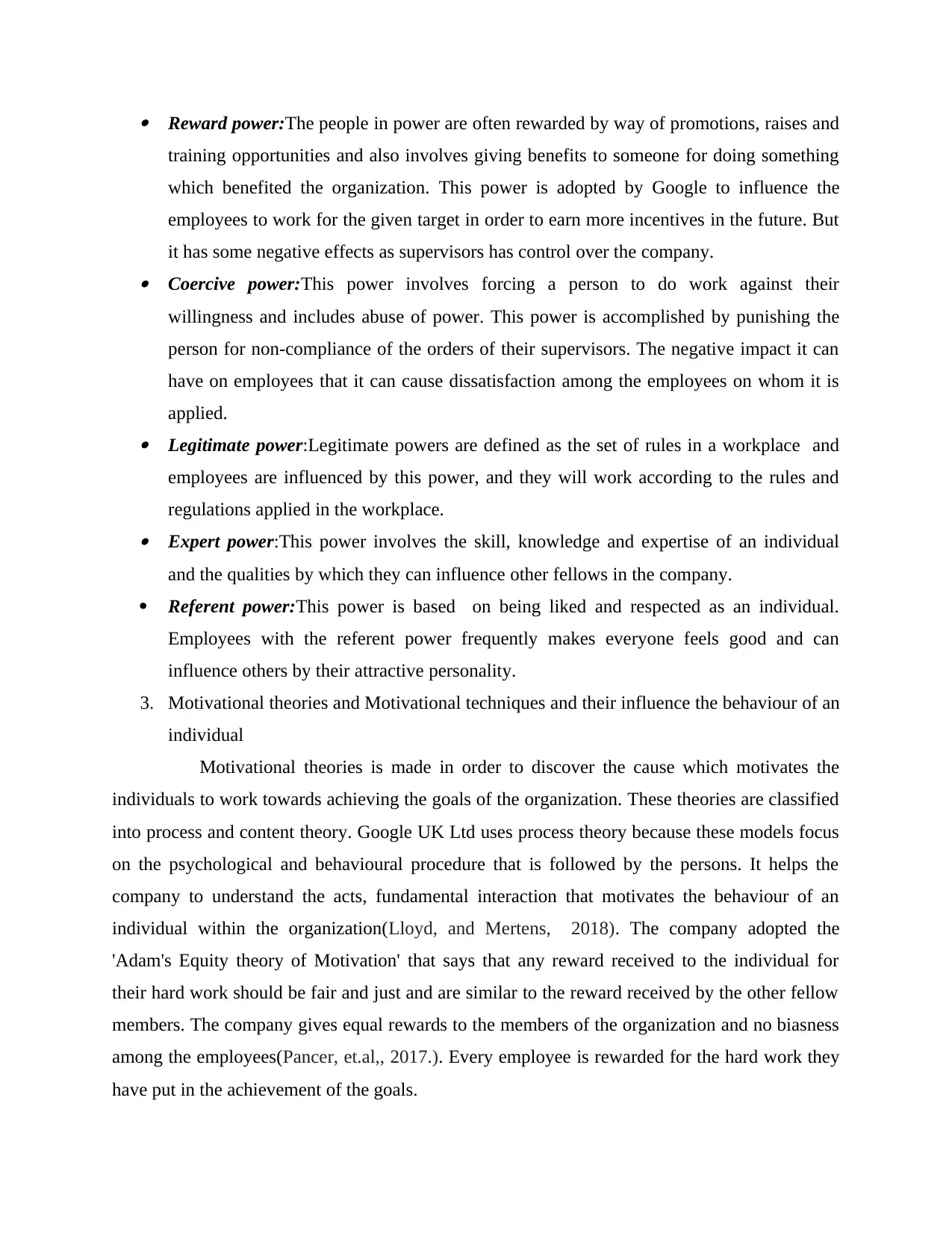
Reward power:The people in power are often rewarded by way of promotions, raises and
training opportunities and also involves giving benefits to someone for doing something
which benefited the organization. This power is adopted by Google to influence the
employees to work for the given target in order to earn more incentives in the future. But
it has some negative effects as supervisors has control over the company. Coercive power:This power involves forcing a person to do work against their
willingness and includes abuse of power. This power is accomplished by punishing the
person for non-compliance of the orders of their supervisors. The negative impact it can
have on employees that it can cause dissatisfaction among the employees on whom it is
applied. Legitimate power:Legitimate powers are defined as the set of rules in a workplace and
employees are influenced by this power, and they will work according to the rules and
regulations applied in the workplace. Expert power:This power involves the skill, knowledge and expertise of an individual
and the qualities by which they can influence other fellows in the company.
Referent power:This power is based on being liked and respected as an individual.
Employees with the referent power frequently makes everyone feels good and can
influence others by their attractive personality.
3. Motivational theories and Motivational techniques and their influence the behaviour of an
individual
Motivational theories is made in order to discover the cause which motivates the
individuals to work towards achieving the goals of the organization. These theories are classified
into process and content theory. Google UK Ltd uses process theory because these models focus
on the psychological and behavioural procedure that is followed by the persons. It helps the
company to understand the acts, fundamental interaction that motivates the behaviour of an
individual within the organization(Lloyd, and Mertens, 2018). The company adopted the
'Adam's Equity theory of Motivation' that says that any reward received to the individual for
their hard work should be fair and just and are similar to the reward received by the other fellow
members. The company gives equal rewards to the members of the organization and no biasness
among the employees(Pancer, et.al,, 2017.). Every employee is rewarded for the hard work they
have put in the achievement of the goals.
training opportunities and also involves giving benefits to someone for doing something
which benefited the organization. This power is adopted by Google to influence the
employees to work for the given target in order to earn more incentives in the future. But
it has some negative effects as supervisors has control over the company. Coercive power:This power involves forcing a person to do work against their
willingness and includes abuse of power. This power is accomplished by punishing the
person for non-compliance of the orders of their supervisors. The negative impact it can
have on employees that it can cause dissatisfaction among the employees on whom it is
applied. Legitimate power:Legitimate powers are defined as the set of rules in a workplace and
employees are influenced by this power, and they will work according to the rules and
regulations applied in the workplace. Expert power:This power involves the skill, knowledge and expertise of an individual
and the qualities by which they can influence other fellows in the company.
Referent power:This power is based on being liked and respected as an individual.
Employees with the referent power frequently makes everyone feels good and can
influence others by their attractive personality.
3. Motivational theories and Motivational techniques and their influence the behaviour of an
individual
Motivational theories is made in order to discover the cause which motivates the
individuals to work towards achieving the goals of the organization. These theories are classified
into process and content theory. Google UK Ltd uses process theory because these models focus
on the psychological and behavioural procedure that is followed by the persons. It helps the
company to understand the acts, fundamental interaction that motivates the behaviour of an
individual within the organization(Lloyd, and Mertens, 2018). The company adopted the
'Adam's Equity theory of Motivation' that says that any reward received to the individual for
their hard work should be fair and just and are similar to the reward received by the other fellow
members. The company gives equal rewards to the members of the organization and no biasness
among the employees(Pancer, et.al,, 2017.). Every employee is rewarded for the hard work they
have put in the achievement of the goals.
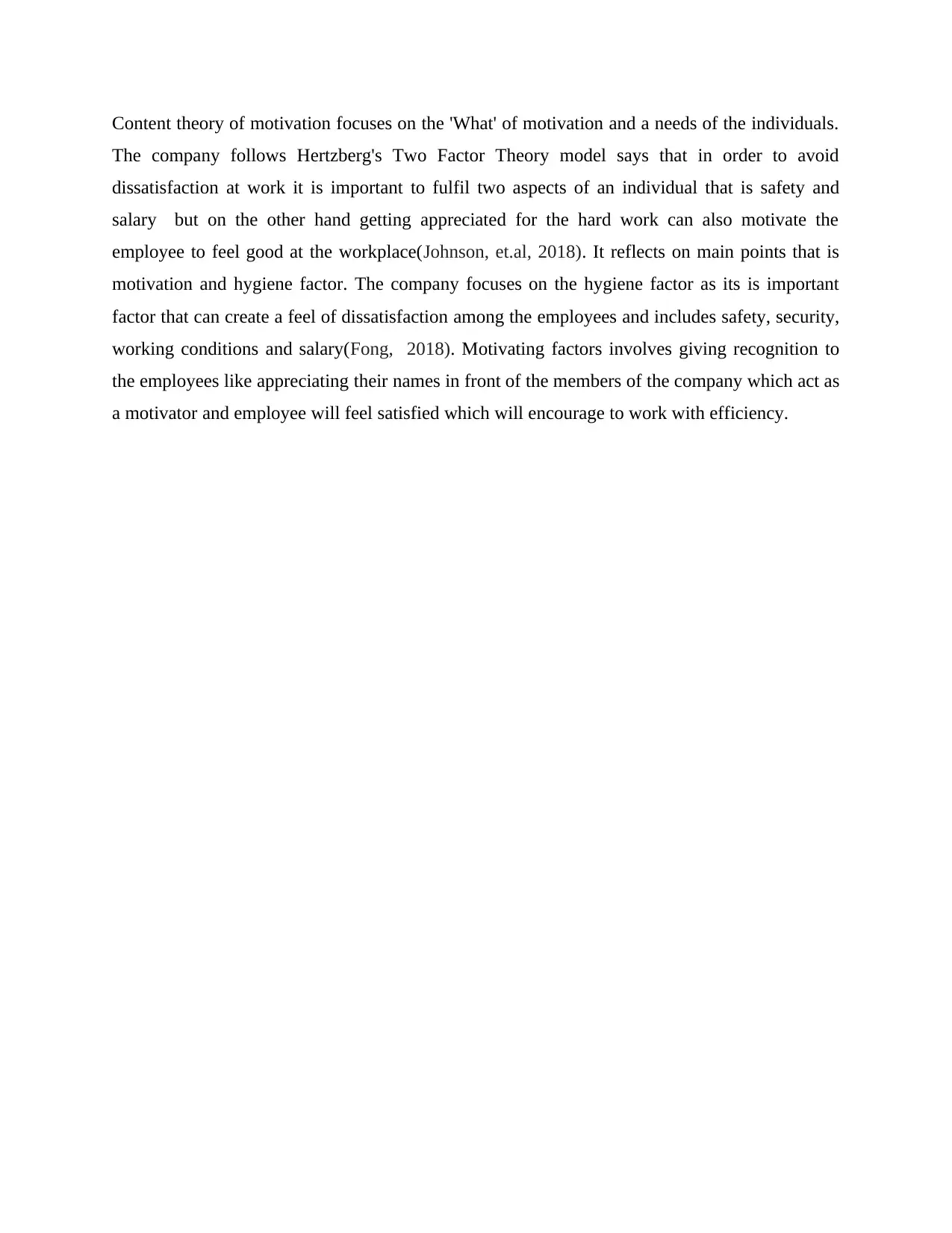
Content theory of motivation focuses on the 'What' of motivation and a needs of the individuals.
The company follows Hertzberg's Two Factor Theory model says that in order to avoid
dissatisfaction at work it is important to fulfil two aspects of an individual that is safety and
salary but on the other hand getting appreciated for the hard work can also motivate the
employee to feel good at the workplace(Johnson, et.al, 2018). It reflects on main points that is
motivation and hygiene factor. The company focuses on the hygiene factor as its is important
factor that can create a feel of dissatisfaction among the employees and includes safety, security,
working conditions and salary(Fong, 2018). Motivating factors involves giving recognition to
the employees like appreciating their names in front of the members of the company which act as
a motivator and employee will feel satisfied which will encourage to work with efficiency.
The company follows Hertzberg's Two Factor Theory model says that in order to avoid
dissatisfaction at work it is important to fulfil two aspects of an individual that is safety and
salary but on the other hand getting appreciated for the hard work can also motivate the
employee to feel good at the workplace(Johnson, et.al, 2018). It reflects on main points that is
motivation and hygiene factor. The company focuses on the hygiene factor as its is important
factor that can create a feel of dissatisfaction among the employees and includes safety, security,
working conditions and salary(Fong, 2018). Motivating factors involves giving recognition to
the employees like appreciating their names in front of the members of the company which act as
a motivator and employee will feel satisfied which will encourage to work with efficiency.
⊘ This is a preview!⊘
Do you want full access?
Subscribe today to unlock all pages.

Trusted by 1+ million students worldwide
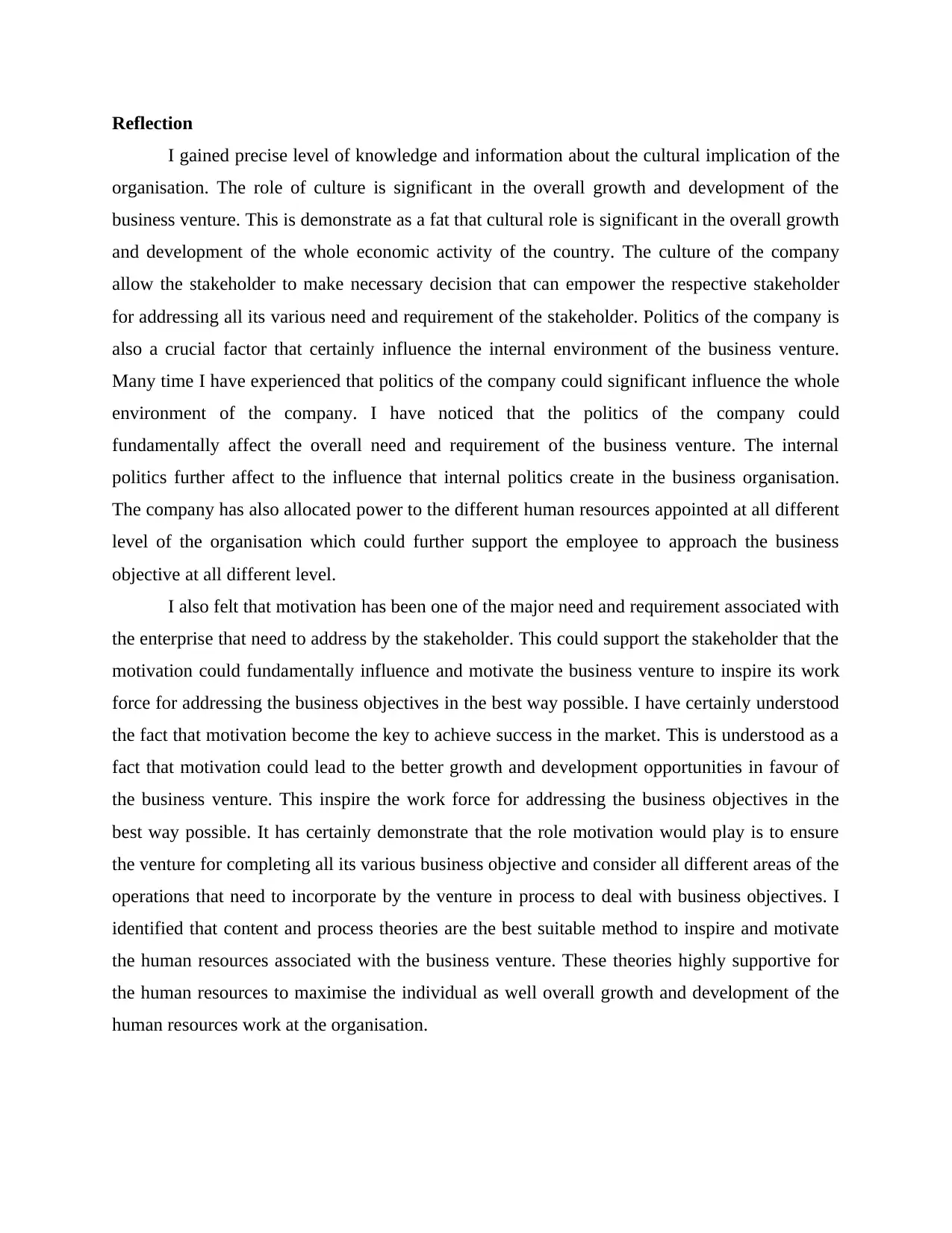
Reflection
I gained precise level of knowledge and information about the cultural implication of the
organisation. The role of culture is significant in the overall growth and development of the
business venture. This is demonstrate as a fat that cultural role is significant in the overall growth
and development of the whole economic activity of the country. The culture of the company
allow the stakeholder to make necessary decision that can empower the respective stakeholder
for addressing all its various need and requirement of the stakeholder. Politics of the company is
also a crucial factor that certainly influence the internal environment of the business venture.
Many time I have experienced that politics of the company could significant influence the whole
environment of the company. I have noticed that the politics of the company could
fundamentally affect the overall need and requirement of the business venture. The internal
politics further affect to the influence that internal politics create in the business organisation.
The company has also allocated power to the different human resources appointed at all different
level of the organisation which could further support the employee to approach the business
objective at all different level.
I also felt that motivation has been one of the major need and requirement associated with
the enterprise that need to address by the stakeholder. This could support the stakeholder that the
motivation could fundamentally influence and motivate the business venture to inspire its work
force for addressing the business objectives in the best way possible. I have certainly understood
the fact that motivation become the key to achieve success in the market. This is understood as a
fact that motivation could lead to the better growth and development opportunities in favour of
the business venture. This inspire the work force for addressing the business objectives in the
best way possible. It has certainly demonstrate that the role motivation would play is to ensure
the venture for completing all its various business objective and consider all different areas of the
operations that need to incorporate by the venture in process to deal with business objectives. I
identified that content and process theories are the best suitable method to inspire and motivate
the human resources associated with the business venture. These theories highly supportive for
the human resources to maximise the individual as well overall growth and development of the
human resources work at the organisation.
I gained precise level of knowledge and information about the cultural implication of the
organisation. The role of culture is significant in the overall growth and development of the
business venture. This is demonstrate as a fat that cultural role is significant in the overall growth
and development of the whole economic activity of the country. The culture of the company
allow the stakeholder to make necessary decision that can empower the respective stakeholder
for addressing all its various need and requirement of the stakeholder. Politics of the company is
also a crucial factor that certainly influence the internal environment of the business venture.
Many time I have experienced that politics of the company could significant influence the whole
environment of the company. I have noticed that the politics of the company could
fundamentally affect the overall need and requirement of the business venture. The internal
politics further affect to the influence that internal politics create in the business organisation.
The company has also allocated power to the different human resources appointed at all different
level of the organisation which could further support the employee to approach the business
objective at all different level.
I also felt that motivation has been one of the major need and requirement associated with
the enterprise that need to address by the stakeholder. This could support the stakeholder that the
motivation could fundamentally influence and motivate the business venture to inspire its work
force for addressing the business objectives in the best way possible. I have certainly understood
the fact that motivation become the key to achieve success in the market. This is understood as a
fact that motivation could lead to the better growth and development opportunities in favour of
the business venture. This inspire the work force for addressing the business objectives in the
best way possible. It has certainly demonstrate that the role motivation would play is to ensure
the venture for completing all its various business objective and consider all different areas of the
operations that need to incorporate by the venture in process to deal with business objectives. I
identified that content and process theories are the best suitable method to inspire and motivate
the human resources associated with the business venture. These theories highly supportive for
the human resources to maximise the individual as well overall growth and development of the
human resources work at the organisation.
Paraphrase This Document
Need a fresh take? Get an instant paraphrase of this document with our AI Paraphraser
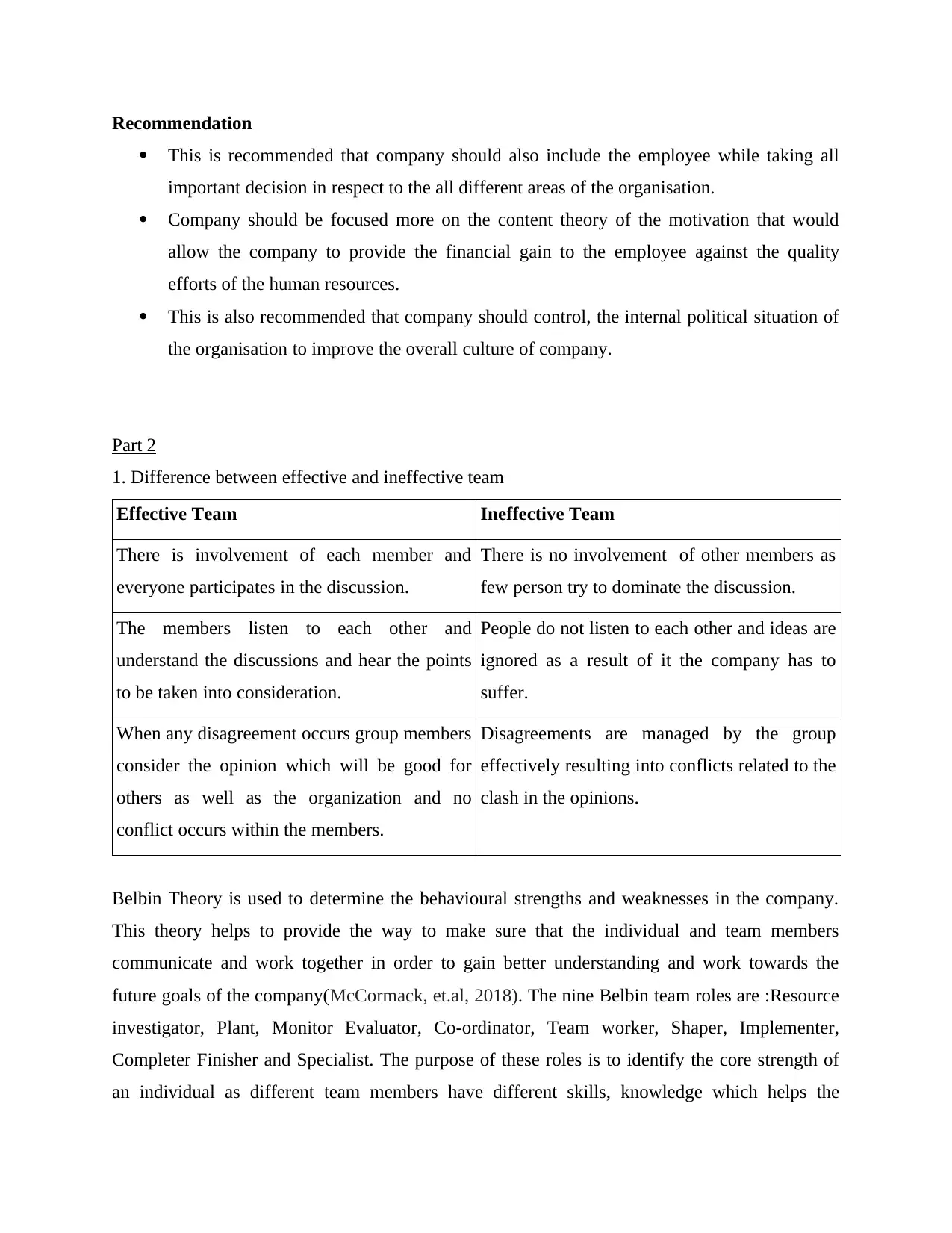
Recommendation
This is recommended that company should also include the employee while taking all
important decision in respect to the all different areas of the organisation.
Company should be focused more on the content theory of the motivation that would
allow the company to provide the financial gain to the employee against the quality
efforts of the human resources.
This is also recommended that company should control, the internal political situation of
the organisation to improve the overall culture of company.
Part 2
1. Difference between effective and ineffective team
Effective Team Ineffective Team
There is involvement of each member and
everyone participates in the discussion.
There is no involvement of other members as
few person try to dominate the discussion.
The members listen to each other and
understand the discussions and hear the points
to be taken into consideration.
People do not listen to each other and ideas are
ignored as a result of it the company has to
suffer.
When any disagreement occurs group members
consider the opinion which will be good for
others as well as the organization and no
conflict occurs within the members.
Disagreements are managed by the group
effectively resulting into conflicts related to the
clash in the opinions.
Belbin Theory is used to determine the behavioural strengths and weaknesses in the company.
This theory helps to provide the way to make sure that the individual and team members
communicate and work together in order to gain better understanding and work towards the
future goals of the company(McCormack, et.al, 2018). The nine Belbin team roles are :Resource
investigator, Plant, Monitor Evaluator, Co-ordinator, Team worker, Shaper, Implementer,
Completer Finisher and Specialist. The purpose of these roles is to identify the core strength of
an individual as different team members have different skills, knowledge which helps the
This is recommended that company should also include the employee while taking all
important decision in respect to the all different areas of the organisation.
Company should be focused more on the content theory of the motivation that would
allow the company to provide the financial gain to the employee against the quality
efforts of the human resources.
This is also recommended that company should control, the internal political situation of
the organisation to improve the overall culture of company.
Part 2
1. Difference between effective and ineffective team
Effective Team Ineffective Team
There is involvement of each member and
everyone participates in the discussion.
There is no involvement of other members as
few person try to dominate the discussion.
The members listen to each other and
understand the discussions and hear the points
to be taken into consideration.
People do not listen to each other and ideas are
ignored as a result of it the company has to
suffer.
When any disagreement occurs group members
consider the opinion which will be good for
others as well as the organization and no
conflict occurs within the members.
Disagreements are managed by the group
effectively resulting into conflicts related to the
clash in the opinions.
Belbin Theory is used to determine the behavioural strengths and weaknesses in the company.
This theory helps to provide the way to make sure that the individual and team members
communicate and work together in order to gain better understanding and work towards the
future goals of the company(McCormack, et.al, 2018). The nine Belbin team roles are :Resource
investigator, Plant, Monitor Evaluator, Co-ordinator, Team worker, Shaper, Implementer,
Completer Finisher and Specialist. The purpose of these roles is to identify the core strength of
an individual as different team members have different skills, knowledge which helps the
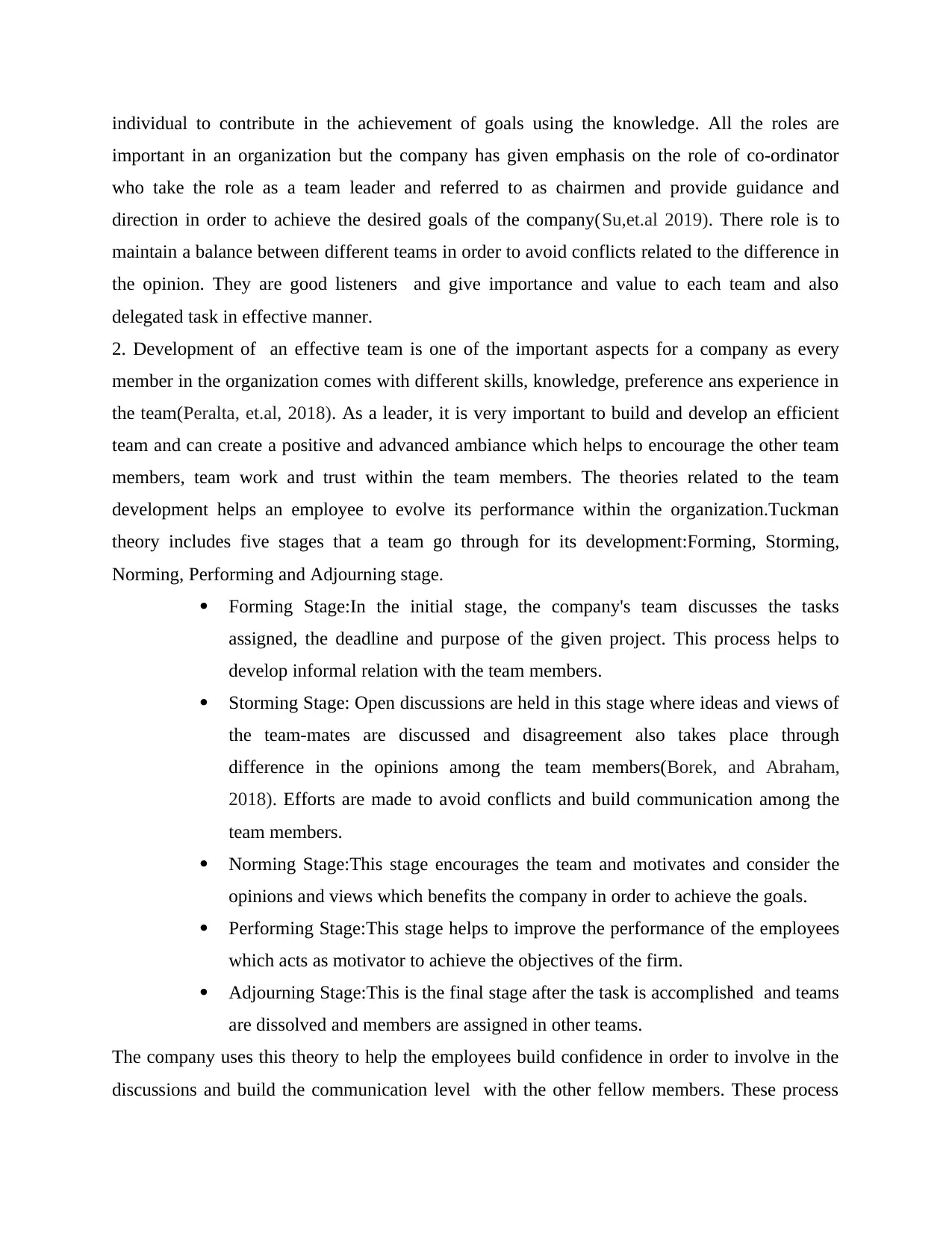
individual to contribute in the achievement of goals using the knowledge. All the roles are
important in an organization but the company has given emphasis on the role of co-ordinator
who take the role as a team leader and referred to as chairmen and provide guidance and
direction in order to achieve the desired goals of the company(Su,et.al 2019). There role is to
maintain a balance between different teams in order to avoid conflicts related to the difference in
the opinion. They are good listeners and give importance and value to each team and also
delegated task in effective manner.
2. Development of an effective team is one of the important aspects for a company as every
member in the organization comes with different skills, knowledge, preference ans experience in
the team(Peralta, et.al, 2018). As a leader, it is very important to build and develop an efficient
team and can create a positive and advanced ambiance which helps to encourage the other team
members, team work and trust within the team members. The theories related to the team
development helps an employee to evolve its performance within the organization.Tuckman
theory includes five stages that a team go through for its development:Forming, Storming,
Norming, Performing and Adjourning stage.
Forming Stage:In the initial stage, the company's team discusses the tasks
assigned, the deadline and purpose of the given project. This process helps to
develop informal relation with the team members.
Storming Stage: Open discussions are held in this stage where ideas and views of
the team-mates are discussed and disagreement also takes place through
difference in the opinions among the team members(Borek, and Abraham,
2018). Efforts are made to avoid conflicts and build communication among the
team members.
Norming Stage:This stage encourages the team and motivates and consider the
opinions and views which benefits the company in order to achieve the goals.
Performing Stage:This stage helps to improve the performance of the employees
which acts as motivator to achieve the objectives of the firm.
Adjourning Stage:This is the final stage after the task is accomplished and teams
are dissolved and members are assigned in other teams.
The company uses this theory to help the employees build confidence in order to involve in the
discussions and build the communication level with the other fellow members. These process
important in an organization but the company has given emphasis on the role of co-ordinator
who take the role as a team leader and referred to as chairmen and provide guidance and
direction in order to achieve the desired goals of the company(Su,et.al 2019). There role is to
maintain a balance between different teams in order to avoid conflicts related to the difference in
the opinion. They are good listeners and give importance and value to each team and also
delegated task in effective manner.
2. Development of an effective team is one of the important aspects for a company as every
member in the organization comes with different skills, knowledge, preference ans experience in
the team(Peralta, et.al, 2018). As a leader, it is very important to build and develop an efficient
team and can create a positive and advanced ambiance which helps to encourage the other team
members, team work and trust within the team members. The theories related to the team
development helps an employee to evolve its performance within the organization.Tuckman
theory includes five stages that a team go through for its development:Forming, Storming,
Norming, Performing and Adjourning stage.
Forming Stage:In the initial stage, the company's team discusses the tasks
assigned, the deadline and purpose of the given project. This process helps to
develop informal relation with the team members.
Storming Stage: Open discussions are held in this stage where ideas and views of
the team-mates are discussed and disagreement also takes place through
difference in the opinions among the team members(Borek, and Abraham,
2018). Efforts are made to avoid conflicts and build communication among the
team members.
Norming Stage:This stage encourages the team and motivates and consider the
opinions and views which benefits the company in order to achieve the goals.
Performing Stage:This stage helps to improve the performance of the employees
which acts as motivator to achieve the objectives of the firm.
Adjourning Stage:This is the final stage after the task is accomplished and teams
are dissolved and members are assigned in other teams.
The company uses this theory to help the employees build confidence in order to involve in the
discussions and build the communication level with the other fellow members. These process
⊘ This is a preview!⊘
Do you want full access?
Subscribe today to unlock all pages.

Trusted by 1+ million students worldwide
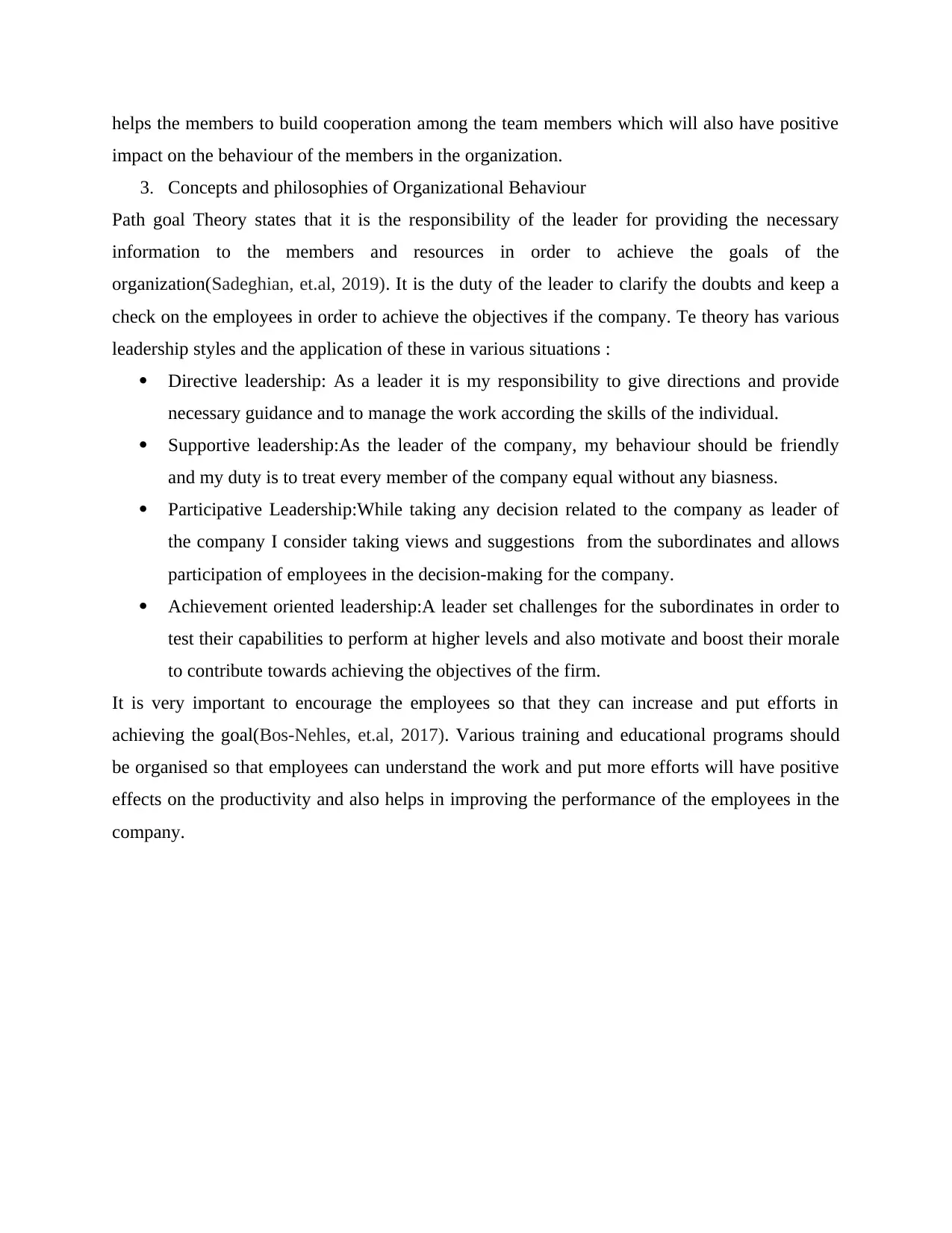
helps the members to build cooperation among the team members which will also have positive
impact on the behaviour of the members in the organization.
3. Concepts and philosophies of Organizational Behaviour
Path goal Theory states that it is the responsibility of the leader for providing the necessary
information to the members and resources in order to achieve the goals of the
organization(Sadeghian, et.al, 2019). It is the duty of the leader to clarify the doubts and keep a
check on the employees in order to achieve the objectives if the company. Te theory has various
leadership styles and the application of these in various situations :
Directive leadership: As a leader it is my responsibility to give directions and provide
necessary guidance and to manage the work according the skills of the individual.
Supportive leadership:As the leader of the company, my behaviour should be friendly
and my duty is to treat every member of the company equal without any biasness.
Participative Leadership:While taking any decision related to the company as leader of
the company I consider taking views and suggestions from the subordinates and allows
participation of employees in the decision-making for the company.
Achievement oriented leadership:A leader set challenges for the subordinates in order to
test their capabilities to perform at higher levels and also motivate and boost their morale
to contribute towards achieving the objectives of the firm.
It is very important to encourage the employees so that they can increase and put efforts in
achieving the goal(Bos-Nehles, et.al, 2017). Various training and educational programs should
be organised so that employees can understand the work and put more efforts will have positive
effects on the productivity and also helps in improving the performance of the employees in the
company.
impact on the behaviour of the members in the organization.
3. Concepts and philosophies of Organizational Behaviour
Path goal Theory states that it is the responsibility of the leader for providing the necessary
information to the members and resources in order to achieve the goals of the
organization(Sadeghian, et.al, 2019). It is the duty of the leader to clarify the doubts and keep a
check on the employees in order to achieve the objectives if the company. Te theory has various
leadership styles and the application of these in various situations :
Directive leadership: As a leader it is my responsibility to give directions and provide
necessary guidance and to manage the work according the skills of the individual.
Supportive leadership:As the leader of the company, my behaviour should be friendly
and my duty is to treat every member of the company equal without any biasness.
Participative Leadership:While taking any decision related to the company as leader of
the company I consider taking views and suggestions from the subordinates and allows
participation of employees in the decision-making for the company.
Achievement oriented leadership:A leader set challenges for the subordinates in order to
test their capabilities to perform at higher levels and also motivate and boost their morale
to contribute towards achieving the objectives of the firm.
It is very important to encourage the employees so that they can increase and put efforts in
achieving the goal(Bos-Nehles, et.al, 2017). Various training and educational programs should
be organised so that employees can understand the work and put more efforts will have positive
effects on the productivity and also helps in improving the performance of the employees in the
company.
Paraphrase This Document
Need a fresh take? Get an instant paraphrase of this document with our AI Paraphraser
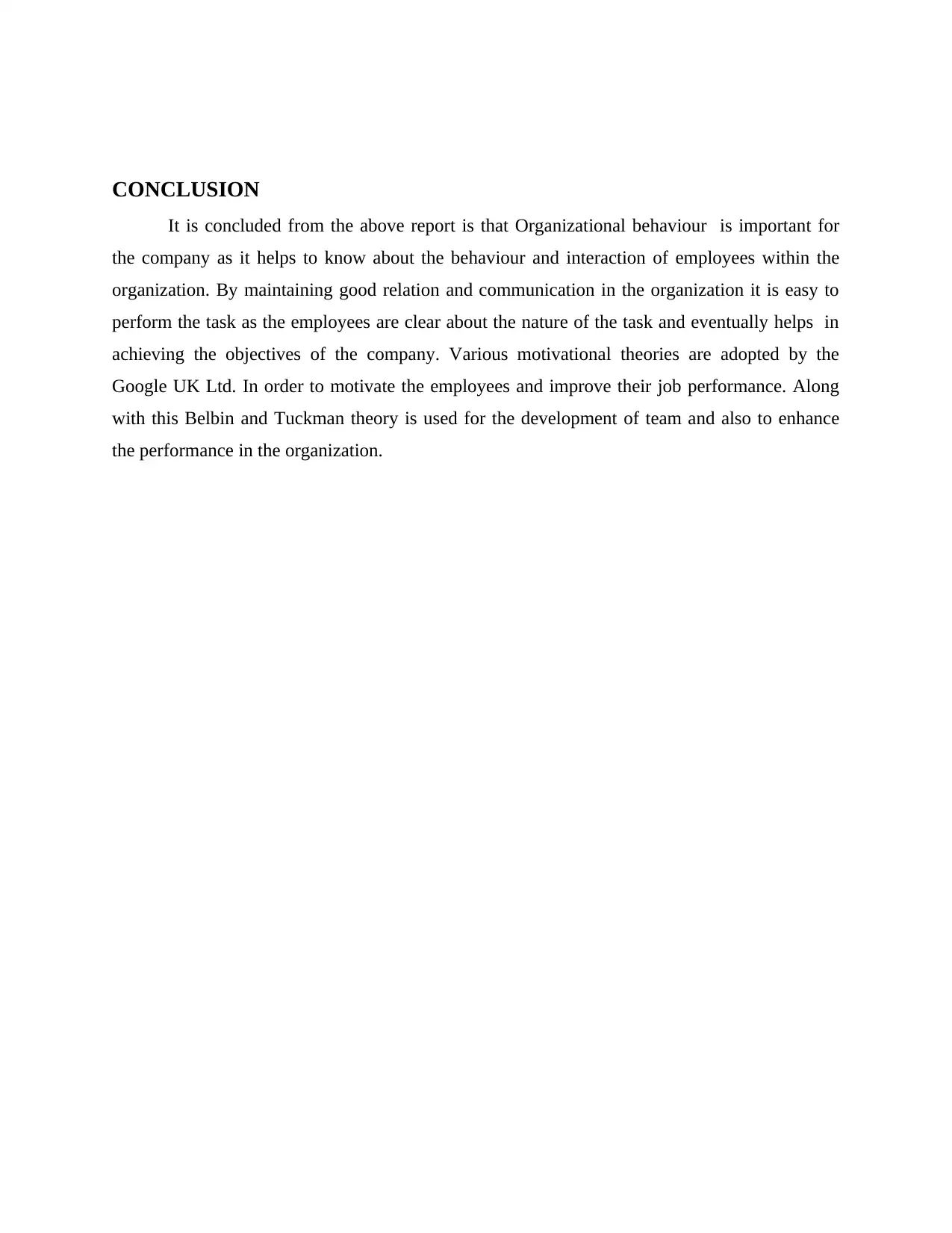
CONCLUSION
It is concluded from the above report is that Organizational behaviour is important for
the company as it helps to know about the behaviour and interaction of employees within the
organization. By maintaining good relation and communication in the organization it is easy to
perform the task as the employees are clear about the nature of the task and eventually helps in
achieving the objectives of the company. Various motivational theories are adopted by the
Google UK Ltd. In order to motivate the employees and improve their job performance. Along
with this Belbin and Tuckman theory is used for the development of team and also to enhance
the performance in the organization.
It is concluded from the above report is that Organizational behaviour is important for
the company as it helps to know about the behaviour and interaction of employees within the
organization. By maintaining good relation and communication in the organization it is easy to
perform the task as the employees are clear about the nature of the task and eventually helps in
achieving the objectives of the company. Various motivational theories are adopted by the
Google UK Ltd. In order to motivate the employees and improve their job performance. Along
with this Belbin and Tuckman theory is used for the development of team and also to enhance
the performance in the organization.
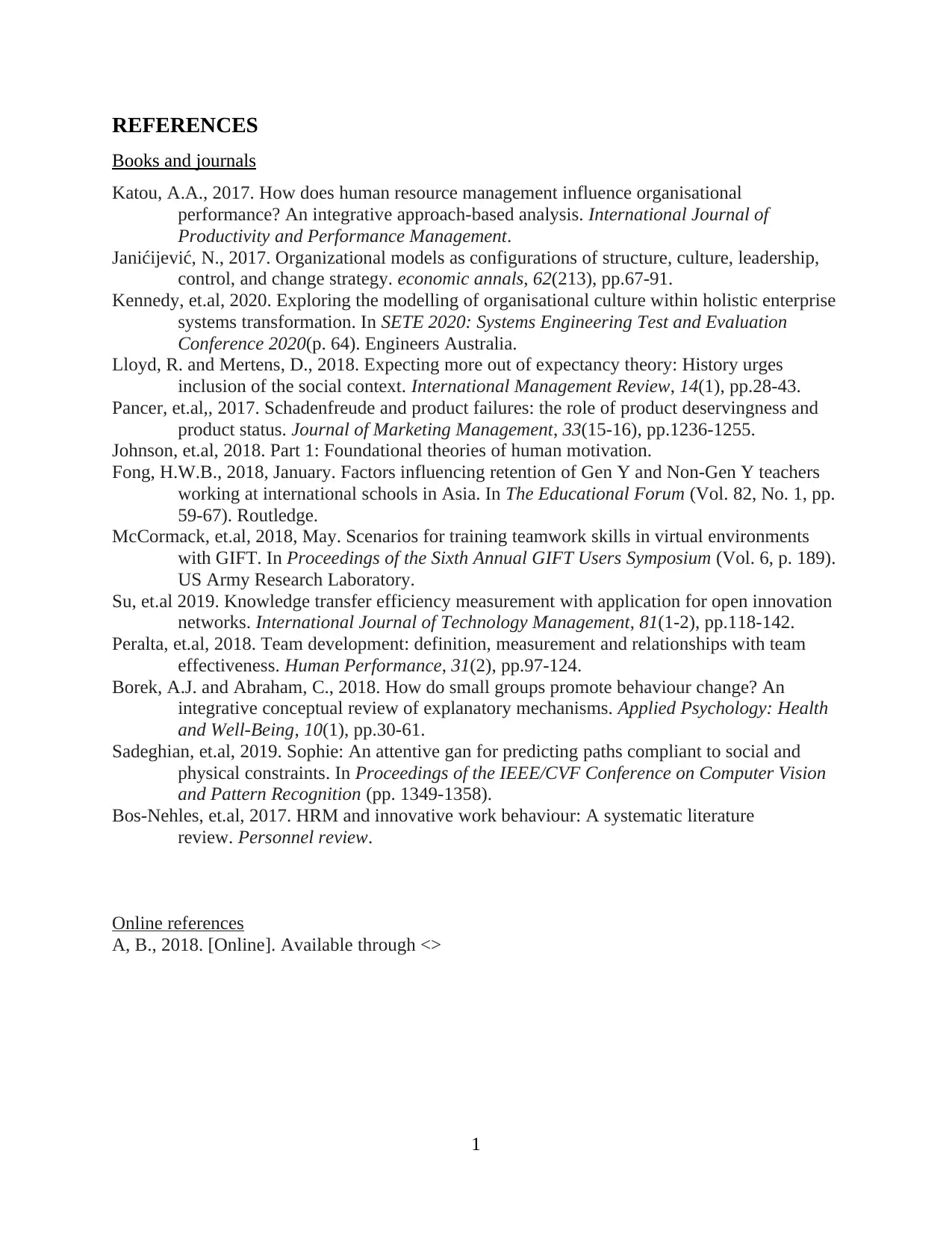
REFERENCES
Books and journals
Katou, A.A., 2017. How does human resource management influence organisational
performance? An integrative approach-based analysis. International Journal of
Productivity and Performance Management.
Janićijević, N., 2017. Organizational models as configurations of structure, culture, leadership,
control, and change strategy. economic annals, 62(213), pp.67-91.
Kennedy, et.al, 2020. Exploring the modelling of organisational culture within holistic enterprise
systems transformation. In SETE 2020: Systems Engineering Test and Evaluation
Conference 2020(p. 64). Engineers Australia.
Lloyd, R. and Mertens, D., 2018. Expecting more out of expectancy theory: History urges
inclusion of the social context. International Management Review, 14(1), pp.28-43.
Pancer, et.al,, 2017. Schadenfreude and product failures: the role of product deservingness and
product status. Journal of Marketing Management, 33(15-16), pp.1236-1255.
Johnson, et.al, 2018. Part 1: Foundational theories of human motivation.
Fong, H.W.B., 2018, January. Factors influencing retention of Gen Y and Non-Gen Y teachers
working at international schools in Asia. In The Educational Forum (Vol. 82, No. 1, pp.
59-67). Routledge.
McCormack, et.al, 2018, May. Scenarios for training teamwork skills in virtual environments
with GIFT. In Proceedings of the Sixth Annual GIFT Users Symposium (Vol. 6, p. 189).
US Army Research Laboratory.
Su, et.al 2019. Knowledge transfer efficiency measurement with application for open innovation
networks. International Journal of Technology Management, 81(1-2), pp.118-142.
Peralta, et.al, 2018. Team development: definition, measurement and relationships with team
effectiveness. Human Performance, 31(2), pp.97-124.
Borek, A.J. and Abraham, C., 2018. How do small groups promote behaviour change? An
integrative conceptual review of explanatory mechanisms. Applied Psychology: Health
and Well‐Being, 10(1), pp.30-61.
Sadeghian, et.al, 2019. Sophie: An attentive gan for predicting paths compliant to social and
physical constraints. In Proceedings of the IEEE/CVF Conference on Computer Vision
and Pattern Recognition (pp. 1349-1358).
Bos-Nehles, et.al, 2017. HRM and innovative work behaviour: A systematic literature
review. Personnel review.
Online references
A, B., 2018. [Online]. Available through <>
1
Books and journals
Katou, A.A., 2017. How does human resource management influence organisational
performance? An integrative approach-based analysis. International Journal of
Productivity and Performance Management.
Janićijević, N., 2017. Organizational models as configurations of structure, culture, leadership,
control, and change strategy. economic annals, 62(213), pp.67-91.
Kennedy, et.al, 2020. Exploring the modelling of organisational culture within holistic enterprise
systems transformation. In SETE 2020: Systems Engineering Test and Evaluation
Conference 2020(p. 64). Engineers Australia.
Lloyd, R. and Mertens, D., 2018. Expecting more out of expectancy theory: History urges
inclusion of the social context. International Management Review, 14(1), pp.28-43.
Pancer, et.al,, 2017. Schadenfreude and product failures: the role of product deservingness and
product status. Journal of Marketing Management, 33(15-16), pp.1236-1255.
Johnson, et.al, 2018. Part 1: Foundational theories of human motivation.
Fong, H.W.B., 2018, January. Factors influencing retention of Gen Y and Non-Gen Y teachers
working at international schools in Asia. In The Educational Forum (Vol. 82, No. 1, pp.
59-67). Routledge.
McCormack, et.al, 2018, May. Scenarios for training teamwork skills in virtual environments
with GIFT. In Proceedings of the Sixth Annual GIFT Users Symposium (Vol. 6, p. 189).
US Army Research Laboratory.
Su, et.al 2019. Knowledge transfer efficiency measurement with application for open innovation
networks. International Journal of Technology Management, 81(1-2), pp.118-142.
Peralta, et.al, 2018. Team development: definition, measurement and relationships with team
effectiveness. Human Performance, 31(2), pp.97-124.
Borek, A.J. and Abraham, C., 2018. How do small groups promote behaviour change? An
integrative conceptual review of explanatory mechanisms. Applied Psychology: Health
and Well‐Being, 10(1), pp.30-61.
Sadeghian, et.al, 2019. Sophie: An attentive gan for predicting paths compliant to social and
physical constraints. In Proceedings of the IEEE/CVF Conference on Computer Vision
and Pattern Recognition (pp. 1349-1358).
Bos-Nehles, et.al, 2017. HRM and innovative work behaviour: A systematic literature
review. Personnel review.
Online references
A, B., 2018. [Online]. Available through <>
1
⊘ This is a preview!⊘
Do you want full access?
Subscribe today to unlock all pages.

Trusted by 1+ million students worldwide
1 out of 13
Related Documents
Your All-in-One AI-Powered Toolkit for Academic Success.
+13062052269
info@desklib.com
Available 24*7 on WhatsApp / Email
![[object Object]](/_next/static/media/star-bottom.7253800d.svg)
Unlock your academic potential
Copyright © 2020–2025 A2Z Services. All Rights Reserved. Developed and managed by ZUCOL.




